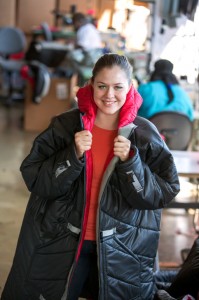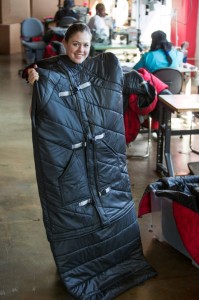In normal application, it would be used to take a little bit of buzz out of your engine or noise out of the wind, but GM has discovered what might be considered a more noble purpose for leftover sound deadening material.
Known as Sonozorb, the insulation is used in doors and other cavities inside General Motors vehicles to reduce wind, road and engine noise. But Veronika Scott approach the maker with an alternative application – to use inside well-insulated, weatherproof coats that could be offered to Detroit’s homeless by a charity she created while still a student.
Better yet, the coats can be quickly transformed into a warm sleeping bag for those who either can’t find or choose not to go to one of the city’s homeless shelters.
“Among other challenges – from design to project funding – the insulation is the largest expense in the coats’ production,” says Scott, who came up with the idea for the coats as a project during her junior year at the Motor City’s College for Creative Studies – which has also turned out many of GM’s designers.
Her charity, the Empowerment Plan in Detroit, has been in operation since December 2010, employing eight previously homeless women to produce an average 150 coats a month. Auto supplier GDC used leftover scraps of Sonzorb to create the filler for Scott’s coats.
“From previous projects, we knew how this material could be reused and approached Veronika and GDC, who quickly agreed to participate,” said John Bradburn, GM’s manager of waste-reduction efforts.
Sonozorb isn’t the sort of material that you’d typical find in an arctic parka or sleeping bag but GM realized it could serve a similar purpose. The maker has provided the charity with 2,000 yards of the sound deadener – enough to produce about 400 coats.
“With GM’s help and recommendations,” adds Scott, “I was able to think about materials in a different way.”
It turns out that Sonozorb has a variety of unexpected applications. Excess material has been used at GM plants to soak up oil spills and during the 2010 BP well blowout in the Gulf of Mexico it was used in booms to corral and absorb spilled oil. The material and oil residue – over 200,000 pounds in all — were reused in the production of Chevrolet Volt plug-in hybrids.
GM is one of many automakers attempting to minimize factory waste. It claims that 102 of its facilities are now “landfill-free,” and that last year it was able to recycle or reuse 2.5 million metric tons of waste materials that otherwise might have been burned, flushed or dumped.


